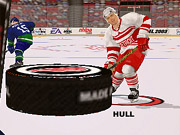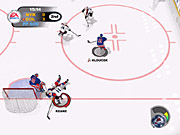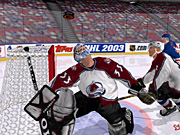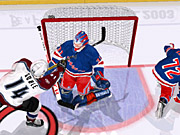There was a time when there were a lot more PC hockey games to choose from--when you could pick a serious simulation, an action-packed, arcade-style game, or even a text-based strategy game. Yet even a half-dozen years ago, one game stood head and shoulders above all the contenders. That game was EA Sports' NHL Hockey. Skillfully developed north of the border by hockey-crazed Canadians, NHL grew from its humble 2D beginnings to become so dominant in the world of computer hockey that it's now the only way to get a good game of hockey going on your PC. NHL 2003 is the latest edition in this series, and it continues a long-standing tradition by offering just enough in the way of improvements to warrant at least a cursory glance from past customers. If you've never played NHL and consider yourself even a casual hockey or sports fan, you owe it to yourself to get the latest game in one of the finest computer sports franchises of all time. However, if you're a veteran player back for another go, you might want to consider putting away those rose-colored glasses and waiting for the inevitable NHL 2004.

Some would argue that EA Sports' NHL series has risen to such prominence due to its impressive television-style presentation, but serious players know that underneath all the gloss lies a sophisticated gameplay engine that delivers an action-packed take on the world's iciest sport. Unfortunately, for all its strength and potential, the series' artificial intelligence has traditionally never been especially realistic. For NHL 2003, EA has improved some areas and left others untouched.
In the latest game, goaltender animations and skills have undergone a serious face-lift. Now, goalies leap and lunge at difficult shots and loose pucks. They'll venture farther from their net and rifle passes to their teammates even when a forechecker sits between them and their target. Fans of the forward's best friend, the deke, will certainly appreciate the game's all-new "dynamic deke control" option, with which they can pull off a broad range of automatic or manually controlled sleight-of-hand maneuvers. And desktop coaches will enjoy instituting individual offensive and defensive strategies for each of their five-on-five, power-play, and penalty-kill units.
Veteran NHL fans will be glad that EA has made sure that NHL 2003's hockey games don't always seem like they have a predetermined winner as they have in previous games. You'll no longer be forced to watch your team lose even as they've outshot their opponents by a 4-to-1 margin and completely dominated every facet of the match. Having said that, NHL 2003, like its forebears, does exercise an unwarranted amount of control over several aspects of the game. Players in the real National Hockey League don't fire the puck over the crossbar when perched just 5 feet from a wide-open net, but in this game they might--if the game decides to keep the score tight.
NHL once again lets you engage in various forms of pure post-whistle violence, leveling your enemies with unexpected, unprovoked body checks when you should be playing fair and square. Although this extracurricular activity is great for a few laughs, EA Sports has somehow allowed players to incur real injuries from such altercations, which doesn't seem right, considering the way fights have been handled in previous games.
Post-whistle shenanigans aren't the only oddities you'll find. Players will, on occasion, overskate the puck for no apparent reason, even while traveling at a walking pace. AI-controlled skaters will sometimes mysteriously adhere to the boards and shuffle their way awkwardly down the ice. Much of the clutching and grabbing hindering the real-life National Hockey League continues to remain in its licensed game as well, even though NHL president Gary Bettman has sworn to eradicate such tedious strategies this season. Furthermore, the game doesn't reflect recent player movements. For the first time in recent memory, the NHL series seems behind the times: For instance, NHL 2003 neglects to shift guys like Andrew Cassels from his former team, the Vancouver Canucks, to his new digs in Columbus.
And that's not all. If you find yourself in a face-off situation just outside the blue line, there's a very good chance someone on your squad will jump offside before you have an opportunity to advance the puck. If you find yourself shooting on an empty net from outside the offensive zone, your oblivious player will simply lob the biscuit into the corner rather than fire it at the unguarded cage. It's this kind of situational unawareness that seriously infringes on NHL's credibility. Simply put, players don't often react in accordance with the current circumstances. This is not the case with EA's FIFA soccer series, where players actually play differently depending on the current score and the remaining time left in the game.
NHL 2003's depiction of fatigue is no less curious. Granted, players noticeably drag their feet or drop their skill level when weary, yet nobody seems perceptibly less mobile after incurring a series of big hits. The infamously little and brittle Saku Koivu can take several crushing smacks on one memorable shift, yet continues to burn along at his typical hearty clip, none the worse for wear. All the above changes drastically, however, if the game decides it's time for an injury and spirits you off the ice and into the dressing room.

In a visual sense, NHL Hockey continues to offer one of the finest depictions of professional sports found anywhere in computer gaming. Sadly, those dazzling introductory sequences of yesteryear have been swapped with somewhat uninteresting footage of various real-life NHL players shamelessly plugging EA's latest sports product. Nevertheless, the game is otherwise so beautifully presented that even a real-life television broadcast would be hard-pressed to look as good.
Off the ice, the development team has fashioned a substantially smoother menu system whereby all pertinent information is accessed from a single interface and the many mini-windows that lie within. As opposed to many recent games, which seem to be moving inexorably to clunky console menu formats, the tight, relatively sophisticated appearance of NHL's pre- and postgame interface is welcome indeed.
The game's interface is both useful and deep, too. In NHL 2003, like in the previous iteration, you can adjust or alter practically any parameter, rule, and display option. If you don't like the sight of two grown men smacking each other about--fighting is thankfully far shorter but no less nonsensical than it was in NHL 2002--you can simply decrease the frequency of fisticuffs or switch if off altogether. You can concoct your own custom-created players, set their skill level as high or as low as you want, and even attach breathe-right strips on their tiny noses. Playing variants include quick game, playoff, international (with a fully stocked crew of international teams), and oodles of multiplayer opportunities, which we'll get into later. You can no longer toggle between an arcade or simulation mode, nor can you hone your skills in a practice or training facility. EA should seriously consider reinstituting the latter for the next installment.

When you enter an NHL 2003 rink, you'll watch your players saunter out from their dressing rooms and onto the ice, bathed in spotlights and the soft glow of pregame mood lighting. Apart from accurate faces, accurate body types, accurate uniforms (including an optional "inaugural" uniform for each team), each player's animation is startlingly lifelike. When the big lights do come up, the game offers long, loving shots of a packed arena, complete with all the heightened trappings of a real-life playoff contest. Subsequently, you're treated to various animated clips depicting all manner of brazen violence, presumably culled from the last time these teams met. The crowd roars its enthusiasm and perhaps does the wave, the players head for their respective benches, and the game is on.
Much has been said about the stunningly high quality of NHL's player models and animations, so a detailed explanation probably isn't necessary at this stage. Suffice to say that for this version, players move their lips and often alter their facial expressions to suit the circumstances. They'll track the puck with their head movements and look upward when the puck is lofted above them. After a goal, they'll mob the scorer rather than standing about or celebrating individually as they did in prior editions. Even during play stoppages, players generally do what real players do, whether that involves a complaint to the referee, a toss of the water bottle at the bench, a simple quick conversation with a teammate, or a heated exchange with an opponent. Although such between-play animations are noticeably more prevalent than they were in NHL 2002 and therefore enhance the general ambience, they also become repetitious after a while.
When NHL 2003 players crash into the protective Plexiglas surrounding the rink, they may shatter it, spraying debris over nearby spectators and forcing the linesmen into clean-up duty. When a new period begins and you find yourself facing the opposite direction than in the previous period, you can hit the Tab key and swap perspectives. Unfortunately, we had trouble accessing NHL's always-outstanding replay component. It appears that the game's replay option is simply unavailable following a whistle until you've lined up for the next face-off.
As spectacular as NHL's graphics have customarily been, its sound traditionally hasn't been far behind. For the 2003 edition, EA has once again created an engaging audio landscape. During gameplay, you're serenaded with the usual impressive range of rink sounds--reverberating puck and stick slaps and bounces, skate swooshes, body check crunches, and the like--but now they seem to emanate from all around you. Even with a two-speaker setup, you'll likely find EA's latest experiments with reverb, echo, and positional placement to be totally convincing.
Back for another stint in the broadcaster's booth is respected Vancouver Canucks play-by-play stalwart Jim Hughson, who delivers his usual upbeat descriptions and insights with trademark flair and enthusiasm. Tagging along with Hughson once again is the very funny and extraordinarily knowledgeable Canadian sportscaster Don Taylor. But Taylor, for some reason, who either kept you in stitches or annoyed you with his truly bizarre witticisms and color commentary in NHL 2002, seems far less amusing and far more irksome this time around. Now, his speech seems forced, more juvenile, and repetitive. Hampered by a smaller word count and a tiresome EA-formulated shtick, this is not the Don Taylor most Canadian sports fans hold in such high regard.
For those who can't have their hockey without massive doses of popular music, NHL 2003 succeeds. Not only does the latest NHL feature some of today's most trendy rock artists (including Jimmy Eat World, Gob, and Default), but it also graphically displays the song and artist currently playing. Even during the game, EA's new Sports Trax will bombard you with tunes such as Papa Roach's "She Loves Me Not." Fortunately, if you want to play hockey without all the pop music, the game has an option to simply switch off the music so that you can focus on what's actually happening on the ice. If you pay particular attention to the improved crowd effects, you'll see that they react intelligently to such events as offside calls and intentional icings.
And NHL 2003's multiplayer has a lot to it. On a single computer, the game supports up to six separate players. Modem, network, and Internet games can handle 12 humans, one for each player on the ice. But it's EA Sports' Online service that really steals the show. The service lets you source opponents of equal ability, join in an ongoing club tournament, or create a custom team and become involved in the ultrarealistic EA Elite, wherein your squad is actually impacted by real-life NHL events.

We took EA Sports Online for a test drive on a cable-modem connection and quickly located plenty of fans who were more than happy to teach us the fine art of losing. Our teams chosen and the parameters set, we headed to the ice and were summarily dismantled--but not before we realized once again that online gaming remains plagued by frame rate problems. In fairness, the game is often quite playable, but it can alternately turn into a slide show or suddenly hurtle players across the ice as though they had jetpacks strapped to their little backs.
In typical EA Sports fashion, the newest NHL is an improved but not essential upgrade. If money is no object or if you're particularly drawn to one of its new perks, you should by all means take the plunge with NHL 2003. But if you already own last year's NHL and aren't made of money, you may want to give it some thought.